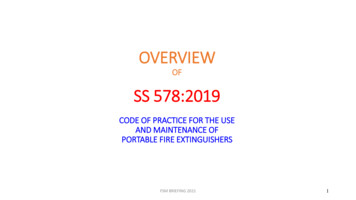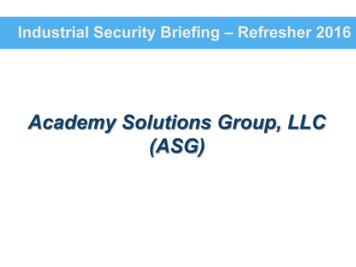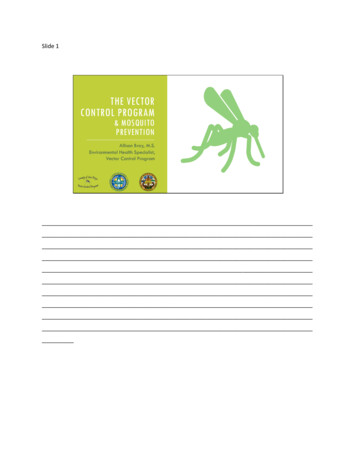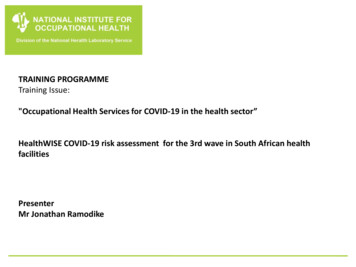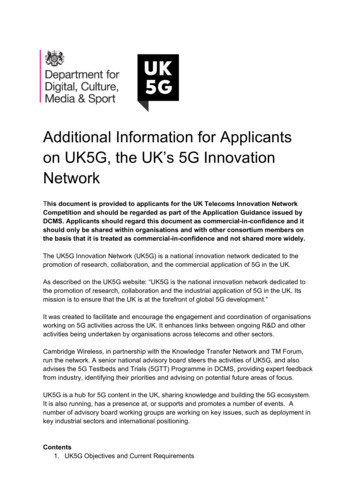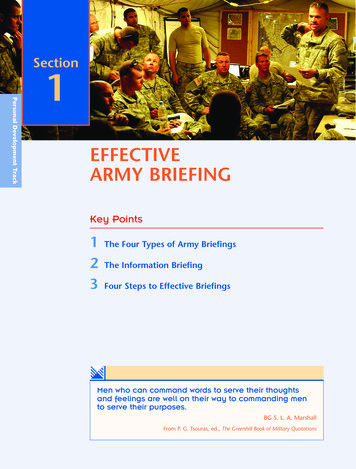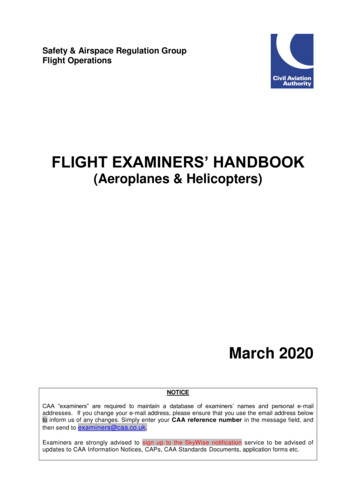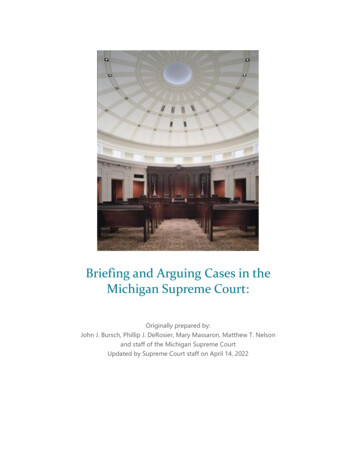
Transcription
Briefing and Arguing Cases in theMichigan Supreme Court:Originally prepared by:John J. Bursch, Phillip J. DeRosier, Mary Massaron, Matthew T. Nelsonand staff of the Michigan Supreme CourtUpdated by Supreme Court staff on April 14, 2022
Table of ContentsINTRODUCTION . 2ORDERS GRANTING LEAVE TO APPEAL OR DIRECTING ARGUMENT ON THE APPLICATION . 2BRIEFS AND APPENDICES. 3Content and Focus . 3Appendices . 4Filing . 5RECORDS . 6ORAL ARGUMENTS . 6Notice and Schedule of Arguments . 6Arrival and Procedure . 7Preparing for Argument. 7Oral Argument Time . 8The Mechanics of Oral Argument . 9Argument in MOAA Cases . 11DECISION-MAKING PROCESS . 12Conferencing and Opinion Writing . 12Order or Judgment . 12GENERAL INFORMATION . 13BIBLIOGRAPHY . 13Page 1
INTRODUCTIONThis guide is intended to assist attorneys with their written and oral advocacy in the MichiganSupreme Court, especially those who are making their first argument before the Court. Inaddition to this guide, counsel should review the following resources: Subchapter 7.300 of theMichigan Court Rules1; the Michigan Supreme Court’s Internal Operating Procedures2; Chapters13 and 14 of the Michigan Appellate Handbook3; Chapter 14 of Civil Appeals by former-JusticeStephen J. Markman4; and Chapter 38, pages 858-865, of the ABA Council of Appellate Lawyers’Appellate Practice Compendium by John J. Bursch and Gaëtan Gerville-Réache5; A Practitioner’sGuide to Effective Advocacy Before the Michigan Supreme Court, by Mary Massaron, pages 3641 Michigan Bar Journal (February 2008)6; and Tips on Advocacy at the Petition Stage, by MaryMassaron, pages 41-46, For the Defense (November 2009).Questions regarding cases to be argued should be directed to the clerk’s office at (517) 3730120. Please have your docket number available before placing the call. To view the docket of aparticular case, visit the “Cases, Opinions & Orders” page7 of the Court’s website and select“Case Search.” You can search by docket number, party name, attorney name, or attorney Pnumber.ORDERS GRANTING LEAVE TO APPEAL OR DIRECTINGARGUMENT ON THE APPLICATIONThe Michigan Supreme Court issues two types of orders in cases to be orally argued: An ordergranting the application for leave to appeal and an order directing argument on the application.The latter order is referred to as a MOAA (pronounced “mō-ah”), an acronym that stands forMini-Oral Argument on the Application. The distinctions between the two order types primarilyinvolve the periods of time for submitting the briefs and the amount of time allowed forargument, and will be explained in greater detailed later in this guide. See Oral Argument Time,infra.1Michigan Court Rules of 1985, Chapter 7. Appellate Rules.Michigan Supreme Court, Internal Operating Procedures (IOPs), Subchapter 7.300 Court Rules.3Brian G. Shannon and Gaëtan Gerville-Réache, eds, Michigan Appellate Handbook (ICLE 3d ed.2014).4Stephen J. Markman et al., Civil Appeals (West Group Michigan Practice Guides 2003).5Appellate Practice Compendium (ABA Publishing 2012).6A Practitioner’s Guide to Effective Oral Advocacy Before the Michigan Supreme Court: WithSpecial Tips from Benjamin Franklin (michbar.org)7“Cases, Opinions & Orders page” of the One Court of Justice website.2Page 2
In most leave granted and MOAA orders, the Court identifies the specific issues that it wants theattorneys to address in their briefs. If specific issues are not identified, the issues raised in theleave applications are to be addressed.If you have a case that is to be argued, you should notify the clerk’s office of any futurescheduling conflicts—e.g., vacations, maternity or paternity leave, proceedings in a differentcourt—as soon as you learn of them. Unless your case is an emergency or priority matter, suchas child custody or termination of parental rights, the Court can usually be flexible in schedulingyour case for argument. The Court is less flexible in adjourning a case once it has been assignedto the case call, especially if counsel failed to timely notify the clerk’s office of a long-standingconflict.You should also immediately advise the clerk’s office if you need any reasonableaccommodations at oral arguments so that suitable arrangements can be made.BRIEFS AND APPENDICESCONTENT AND FOCUSBriefs in calendar cases8 must be prepared in accordance with MCR 7.312(A), which referencesthe requirements of the Court of Appeals’ briefing rule, MCR 7.212. Supreme Court briefs shouldaddress the legal correctness of the appealed disposition; the specific facts of a case are lessimportant than the proposition of law. Appellants’ briefs must seek to convince the Court toadopt a new rule of law, change an existing rule, construe a statute that has not beeninterpreted before, or correct a previous construction that you believe was wrongly decided. Useonly those parts of earlier pleadings that advance your cause at this point in the proceedings.You should write clearly and concisely, using plain language and avoiding legalese. Organizeyour arguments logically to establish your points without getting sidetracked by tangentialissues or inconsequential facts. Proofread carefully, cite-check all cited cases to ensure that theyhave not been reversed or overruled, and confirm that every case stands for the proposition forwhich it is cited. Accurately summarize, paraphrase, or cite cases and portions of the record soas not to mislead the Court. Even an innocent misstatement can jeopardize your credibility andthat of your brief. Prioritize your arguments and winnow out those that are less persuasive. Statethe precise relief you are asking the Supreme Court to grant and explain why that request is8A calendar case is one in which the Court has granted the application for leave to appeal or anoriginal action that is to be argued at a monthly session (e.g., a JTC disciplinary case). MCR7.313(A).Page 3
supported by the law and facts. Avoid impugning the lower courts, opposing counsel, or otherparties.When preparing your brief, understand your audience. The Justices and their law clerks aregeneralists so your brief should educate as well as inform. Explain the “big picture” of theapplicable area of the law to the Court and indicate how your case fits within that area. Draw theCourt a roadmap of how it is to get from point A (the current state of the law) to point B (theposition you are advocating). This is especially critical if prior Court of Appeals or Supreme Courtcases need to be overruled or the common law need to be changed.Keep in mind that the Court’s priority is to develop or clarify the jurisprudence of the state; it isnot necessarily concerned with the outcome of a particular case. That the Court has agreed tohear oral argument clearly indicates that it has an interest in the ramifications of the case.Explain that significance to the Court and describe how a decision in your favor will have apositive impact beyond resolving your case. On the macro level, tell the Court what you believethe thesis of its opinion should be and explain why the law supports that thesis. Tell the Courtthe “rule of law” that you would like it to articulate in your case and all similar cases that willcome before the state’s courts. On the micro level, tell the Court how to support that thesis orrule by applying the law to the specific facts of your case.APPENDICESThe appellant and appellee may file joint or separate appendices with their briefs on appeal.Joint or individual appendices must include: (1) the trial court/tribunal judgment or order beingappealed, along with any written opinions, memorandum, findings of fact or conclusions of lawstated on the record; (2) the trial court/tribunal register of actions; (3) relevant pages of anytranscripts cited in support of an argument, (4) when a jury instruction is challenged, thelanguage of the instruction and those portions of the transcript whether the instruction isdiscussed or requested; (5) any other relevant exhibits, pleadings, or evidence submitted to thetrial court/tribunal; and (6) the Court of Appeals opinion or order being appealed. Appendicesmust contain a table of contents and must be paginated sequentially at the bottom of thepages. MCR 7.312(D), 7.212(J)(2). Appendices that are filed electronically must be a separate filefrom the e-brief and transmitted as a single PDF unless the file size exceeds the 25 MB limitationof the MiFILE system, in which case it can be separated into two or more PDF documents.Electronic appendices must be text-searchable and bookmarked. Appendices filed in hard copymust be separate from the brief and bound in a manner that can be easily taken apart forscanning, MCR 7.312(D), 7.212(J)(2).Page 4
FILINGImportant Note: Hard copies of briefs and appendices need not be provided to the Court if theywere electronically filed using the appellate e-filing system, MiFILE. Beginning on February 1,2020, attorneys must submit their briefs and appendices through the MiFILE system. AdminOrder 2014-23. Filings may be transmitted to the MiFILE system 24 hours a day, seven days aweek (with the exception of the system’s downtime required for periodic maintenance).Electronically filed documents that are received by 11:59:59 PM Eastern Time on a business daywill be docketed as being filed that day. Electronic filings received between 12:00 a.m. and 11:59p.m. on a Saturday, Sunday or court holiday will be docketed on the next business day. MCR1.108(1) and MCR 8.110(D)(2).Self-represented litigants may use the MiFILE system or they may mail or deliver one set of theoriginal signed documents to the Clerk’s Office at 925 W. Ottawa Street, P.O. Box 30052,Lansing, MI 48909.The appellant’s brief and appendices are due within 56 days after the date on the order grantingleave to appeal unless a different time is specified in the Court’s order. MCR 7.312(E)(1) & (J)(1).The appellee must file its responsive brief and appendix, if any, within 35 days after receivingservice of the appellant’s brief. MCR 7.312(E)(2). The appellant may file a reply brief within 21days after receiving service of the appellee’s brief. MCR 7.312(E)(3). The Court, on its own motionor that of a party, may order a longer or shorter briefing period. MCR 7.312(J)(1). A brief isconsidered filed on the date the clerk’s office receives it, not on the date you mailed it, with theexception of briefs submitted by incarcerated parties. A motion to extend the due date of abrief should be filed in advance of the brief deadline whenever possible. The motion must showthat there is good cause for the extension and that the delay in filing is not due to the culpablenegligence of the party or attorney. MCR 7.316(B).SERVICEA party must serve two copies of its brief and appendix on each attorney who has appeared fora separate party or group of parties and on each party appearing pro se. MCR 7.312(F)(2). Incriminal cases and cases in which the state is a party or interested, each party must also serveone copy of its brief and appendix on the Attorney General. MCR 7.312(F)(3). Service must beaccomplished in a manner allowed under the court rules, such as by first-class mail, handdelivery, or e-mail. MCR 2.107(C).The hard copy service requirements do not apply if the parties are electronically served throughthe MiFILE system. Registered MiFILE users agree to accept e-service through the MiFILE systemunless and until the user’s registration is terminated. A document electronically filed afterPage 5
11:59:59 PM Eastern Time, or on a Saturday, Sunday, or court holiday shall be deemed to havebeen filed or served on the next business day. MCR 1.108(1) & MCR 8.110(D)(2).RECORDSThe record before the Supreme Court consists of the materials filed in or generated by both thetrial court/tribunal and the Court of Appeals, including the pleadings, motions, transcripts, andcourt opinions and orders. MCR 7.310(A). The lower court records are received, either in hardcopy form or electronically, at the application stage before entry of the order granting leave ordirecting argument on the application.The Supreme Court returns the original record to the appropriate court or tribunal after itsdecision is final. MCR 7.310(B).ORAL ARGUMENTSNOTICE AND SCHEDULE OF ARGUMENTSApproximately 35 days before the next case call, the clerk of the Court emails the notice of casesto be argued to the attorneys of record, including attorneys for amici curiae. Arguments areusually scheduled on Wednesday and Thursday of the first or second week of January, March,April, May, October, November, and December. Except in special or emergency situations,arguments are not scheduled in February, June, July, August, and September. But see, e.g., In reRequest for Advisory Opinion Regarding Constitutionality of 2011 PA 38, 490 Mich 295; 806NW2d 683 (2011) (argued September 7, 2011).The notice of arguments indicates the dates of the case call and identifies the attorneys who arepresumed to argue on behalf of the parties. You must notify the clerk’s office immediately if adifferent attorney will actually argue the case. Most arguments are held in the 6th floorcourtroom in the Hall of Justice, Lansing. But once or twice a year, arguments are held at an offsite location across the state as part of the Court Community Connections program.The schedule of arguments is posted on the Court’s website at least 21 days before the first dayof argument. The schedule lists the date and approximate start time of the arguments in eachcase. Attorneys who are endorsed to argue should check in with the clerk’s office on the 4thfloor of the Hall of Justice at least 15 to 20 minutes before the arguments are scheduled tobegin.Page 6
If you failed to request oral argument on the title page of your brief as required by MCR7.312(C), you will not be allowed to argue unless you file a motion for oral argument at least 21days before the first day of argument. MCR 7.313(B)(2). If neither party reserves the right to oralargument, the court clerk designates the case as submitted on the briefs. MCR 7.312(B)(2). Theparties may stipulate at any time that a case be submitted on the briefs. MCR 7.314(A).Oral argument sessions are public hearings that open to all citizens and members of the media.ARRIVAL AND PROCEDUREDriving directions and parking instructions are available on the Supreme Court’s website. Youshould allow yourself sufficient time to drive to Lansing (or other argument location) to take intoaccount possible delays due to the traffic or poor weather conditions, as well as the time neededto pass through the security screening at the Hall of Justice, which may be five to ten minutesdepending on the number of people coming into the building. By arriving early to thecourtroom you can observe other arguments to get a sense of the Justices’ level of engagementwith the attorneys.The Chief Justice will call each case when the Court is ready to hear the arguments. Theattorneys should move as quickly as possible to the tables at the front of the courtroom.Counsel for the appellant sits at the table to the right of the podium (as you face the bench) andcounsel for the appellee sits at the left side table. Parties are not permitted to sit at the counseltables during argument.PREPARING FOR ARGUMENTOral arguments should emphasize and clarify the arguments in your written brief and not simplysummarize your brief. Argument is your opportunity to stress the main issues and arguments ofthe case that might persuade the Supreme Court in your favor. The argument you prepareshould reflect the unique focus of the Supreme Court. Though precedent is important, yourargument should also stress the practical implications of the Court’s decision. Prior caseholdings may not be as important as they are in the Court of Appeals. The fact that the Courthas granted review suggests that the Justices intend to reexamine the issue rather thanautomatically follow precedent.The oral arguments of the Supreme Court are streamed live on its website and are archived forlater viewing on its YouTube channel. If you have not previously appeared before the Court, youshould watch several arguments (live or recorded) in advance of your own to get a sense of howto effectively argue before the Court.Being prepared for oral argument requires a thorough knowledge of the record, the generalarea of the law governing the case, and the law as applied to the specific facts of record. YouPage 7
should review all the briefs and the record to re-familiarize yourself with the procedural history,the relevant substantive facts, the applicable law, and the cases cited in the briefs. You shouldalso search for any pertinent cases that were issued after the briefs were filed. Review andunderstand the finer points of your opponent’s argument, as well as your own. You should befamiliar enough with the case that you could argue either side, and be aware of the strengthsand weaknesses of both positions.The Justices will be familiar with the factual background and procedural history of your case soyou should spend little, if any, time discussing it unless it directly bears on issue. You should,however, be prepared to answer any questions that arise regarding those aspects of the case.Be aware that oral argument before the Supreme Court is not simply an occasion to argue thepoints in your brief. You should re-examine and rethink every aspect of your case to determinewhether there is another legal basis that supports your position. The Justices have conductedindependent research on your case so you should not be surprised if they approach it from adifferent perspective than that in the appeal briefs.The Justices will ask questions that focus the argument on what they view to be the mostdifficult questions of law. To anticipate their questions and concerns, familiarize yourself withindividual Justice’s decisions in the relevant area of law. If an earlier Supreme Court opinion isparticularly important to your case, note whether any current Justices also participated in thatcase and, if so, how they voted. This will give you an idea of which Justices are likely to bereceptive to your argument and which are likely to be resistant.In arguing before the Supreme Court, counsel should anticipate a thorough interrogation.Expect numerous questions from the Justices addressing your arguments, as well as those ofyour opposing counsel. In preparing for your argument, you should try to anticipate thequestions the Justices will ask and prepare to answer them. Be able to defend the weak points ofyour position against attacks from your opponent and questions from the Justices.ORAL ARGUMENT TIMEThe Supreme Court order granting the leave application will specify the time allowed for oralargument. MCR 7.314(B)(1). In most cases, each side is allowed twenty minutes for argument.Some cases may be granted thirty minutes to argue. If a case has multiple appellants orappellees, all parties on the same side must divide the time allotted for argument.When a case is called, the appellant’s counsel should step to the lectern and begin when theChief Justice signals either verbally or by turning on the flashing yellow light at the front of thepodium. The appellee’s counsel should step to the podium when the appellant’s counsel stepsaway and similarly await a verbal signal or the turning on of the flashing yellow light beforePage 8
beginning. Both attorneys should begin by introducing themselves and stating which party orparties they represent.The Supreme Court’s practice is to allow counsel two minutes of uninterrupted argument; aflashing yellow light on the podium marks this period. Use this time to set forth what youconsider to be your most important arguments. You may waive the uninterrupted period inwhole or in part. If you intend to waive the entire period, tell the Court at the beginning of yourargument.Counsel for the appellant may reserve time to rebut the appellee’s attorney’s argument byrequesting at the beginning of the initial argument a specified number of minutes for rebuttal.Counsel for the appellee is not entitled to any rebuttal time. Be aware that it is solely theresponsibility of the appellant’s counsel to keep track of the time reserved for rebuttal socounsel may want to bring a stop watch or a smart phone with that function to the lectern withthem. If the appellant’s counsel uses all the argument time in the initial argument, regardlesswhether the time was spent answering the Justices’ questions, counsel will be denied rebuttalargument despite reserving it.If review was granted on the basis of more than one application, the Court generally indicatesthe sequence of argument. If no sequence is specified, the parties should assume that the partywho filed the first application will argue first.Expect that you may be subject to questions from the Justices during the entire argument time(or longer if the questioning continues beyond the allotted time). The yellow light indicates thatyou have five minutes remaining, and the red light indicates that your allotted time is up.If you have made all points you intended to make and yet still have time left, you shouldconclude with a brief summary of your argument and tell the Justices that you would be happyto answer any further questions. If there are none, return to your seat at counsel’s table. You riskdiminishing the impact of your argument by mechanically reverting to prepared text. And, theJustices will appreciate your brevity.THE MECHANICS OF ORAL ARGUMENTHave your argument well prepared. While outlines and notes are appropriate, the SupremeCourt looks with disfavor on an argument that is read from prepared text. Think of and presentyour oral argument as a conversation with the Justices, rather than as a prepared speech. Makeand maintain eye contact with the Justices as much as possible. This may allow you to seewhether the Justices are following your arguments, or are bored, confused, or disagree withsomething you have said.Page 9
In making your argument, be candid and credible. Start off forcefully, making your strongestpoints. Just as in your briefing, you should refrain from gratuitous attacks on the lower courts oryour opponent. Attempts at humor or sarcasm are risky and should be avoided.To be an effective advocate for your client, it is important to have a theory of the case and stayon message throughout the argument. Begin by outlining your theory and the main points youintend to make. Give the Justices a roadmap. Don’t dwell on the specific facts of your case;instead, provide the Justices with your thesis. Be prepared to explain how you would write theopening and concluding paragraphs of the Court’s opinion.Be ready to argue your case entirely without interruption but anticipate questions from theJustices. Questions are opportunities to clarify your argument and help the Justices come toyour position. The Justices’ questions are invaluable clues to what concerns them about thecase; embrace the opportunity to alleviate their concerns. Note, however, that the questions andcomments of a Justice do not necessarily indicate the manner in which he or she intends to voteor analyze the case. Justices who are favorable to your position may occasionally ask questionsthat are intended to persuade their colleagues on the bench. Seize these opportunities whenthey arise.If a Justice interrupts you when you are speaking, you should stop talking immediately andlisten. Promptly addressing a Justice’s question is much more important to succeeding in oralargument than continuing with your argument. Listen carefully to what the Justices say in theirquestions and comments to both you and opposing counsel. Be flexible enough to respondaffirmatively to new theories or new interpretations set forth by a Justice. If you do notunderstand a question, ask the Justice to clarify it. If you don’t know the answer to a question,don’t guess. If you are wrong, the Justices may think that you are either attempting to misleadthem or that you incorrectly believe something to be true that is not. It is better to acknowledgethat you do not know the answer, than to answer incorrectly. Instead, offer to provide asupplemental brief on the question after arguments if the Justices would like.In responding to the Justices’ questions, do not be overbearing or aggressive but, conversely,you should not be timid. It is perfectly acceptable to respectfully tell a Justice that you believe heor she is incorrect on a point, and explain why. It is also acceptable to challenge the premise of aJustice’s question in answering, or to explain why you believe that a hypothetical situation beingposed is distinguishable from your case.Do not avoid or fail to answer a Justice’s question. Rather than avoiding a question that hurtsyour argument, either concede the point, as appropriate, or explain why the point is notdispositive of your case and why your side still should prevail. For example, you might suggestthat the question is focused on an irrelevant matter, that it misperceives what is principally incontroversy, or that it requires some elaboration. If you think that a question is not particularlyPage 10
important or relevant, do not demean or reject it; simply respond to the question and thenreturn to the point you were making.Again, it is important to remember that, from the perspective of the Justices, oral argument isnot just about your case. It is about the rule of law that the Court will lay down for future cases.Be prepared to address how your case will affect other cases. Understand and be prepared todiscuss the policy implications of your case for the state’s jurisprudence, which is to say that youshould be ready to discuss the potentially far reaching implications of the rule you are urgingthe Court to adopt.ARGUMENT IN MOAA CASESUnder MCR 7.305(H)(1), the Supreme Court may direct oral arguments on whether to grantleave to appeal or take other action on an application, such as affirming or reversing the Courtof Appeals, remanding to the Court of Appeals for consideration as on leave granted, orremanding to the trial court/tribunal for further proceedings. A MOAA gives the Supreme Courtan opportunity to explore the issues involved in the case without the full briefing andsubmission that follow a grant of leave to appeal.A MOAA order will state whether the parties are required or permitted to file supplementalbriefs. The briefing schedules are established by MCR 7.312(E) unless the Court directs adifferent time. MOAAs are scheduled for oral argument and discussed at conference in the samemanner as calendar cases.The same rules for oral argument in calendar cases apply to MOAAs except that each side isgenerally limited to 15 minutes of argument. Given the limited time for argument, reserving timefor rebuttal, while possible, may be impractical. It is therefore imperative that you are clear andconcise when making your arguments and answering questions.Keep in mind that if the Court has ordered a MOAA, it is likely interested in a specific issue thatit considers important but is unsure whether that issue warrants a full grant. Oftentimes theissue will be flagged in the order directing argument. If so, your supplemental briefing and oralargument should focus on that issue. It will likely be regarded as controlling by the Court.It is also important to recognize that, in MOAA cases, the Court is less likely to issue a fullopinion following argument and instead may resolve the case in a more summary fashion, eitherby order or in a memorandum or per curiam opinion. Think carefully about what you would likethe Court to do, and discuss and defend your position at oral argument. If you believe the casecan be resolved with a peremptory order, be prepared t
1 Michigan Court Rules of 1985, Chapter 7. Appellate Rules. 2 Michigan Supreme Court, Internal Operating Procedures (IOPs), Subchapter 7.300 Court Rules. 3 Brian G. Shannon and Gaëtan Gerville-Réache, eds, Michigan Appellate Handbook (ICLE 3d ed. 2014). 4 Stephen J. Markman et al., Civil Appeals (West Group Michigan Practice Guides 2003).

